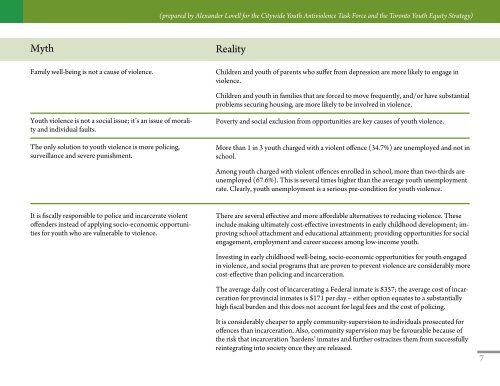backgroundfile-65634
backgroundfile-65634
backgroundfile-65634
Create successful ePaper yourself
Turn your PDF publications into a flip-book with our unique Google optimized e-Paper software.
(prepared by Alexander Lovell for the Citywide Youth Antiviolence Task Force and the Toronto Youth Equity Strategy)<br />
(prepared by Alex Lovell for the Citywide Youth Antiviolence Task Force and the Toronto Youth Equity Strategy)<br />
Myth<br />
Family well-being is not a cause of violence.<br />
Reality<br />
Children and youth of parents who suffer from depression are more likely to engage in<br />
violence.<br />
Children and youth in families that are forced to move frequently, and/or have substantial<br />
problems securing housing, are more likely to be involved in violence.<br />
Youth violence is not a social issue; it’s an issue of morality<br />
and individual faults.<br />
The only solution to youth violence is more policing,<br />
surveillance and severe punishment.<br />
Poverty and social exclusion from opportunities are key causes of youth violence.<br />
More than 1 in 3 youth charged with a violent offence (34.7%) are unemployed and not in<br />
school.<br />
Among youth charged with violent offences enrolled in school, more than two-thirds are<br />
unemployed (67.6%). This is several times higher than the average youth unemployment<br />
rate. Clearly, youth unemployment is a serious pre-condition for youth violence.<br />
It is fiscally responsible to police and incarcerate violent<br />
offenders instead of applying socio-economic opportunities<br />
for youth who are vulnerable to violence.<br />
There are several effective and more affordable alternatives to reducing violence. These<br />
include making ultimately cost-effective investments in early childhood development; improving<br />
school attachment and educational attainment; providing opportunities for social<br />
engagement, employment and career success among low-income youth.<br />
Investing in early childhood well-being, socio-economic opportunities for youth engaged<br />
in violence, and social programs that are proven to prevent violence are considerably more<br />
cost-effective than policing and incarceration.<br />
The average daily cost of incarcerating a Federal inmate is $357; the average cost of incarceration<br />
for provincial inmates is $171 per day – either option equates to a substantially<br />
high fiscal burden and this does not account for legal fees and the cost of policing.<br />
It is considerably cheaper to apply community-supervision to individuals prosecuted for<br />
offences than incarceration. Also, community supervision may be favourable because of<br />
the risk that incarceration ‘hardens’ inmates and further ostracizes them from successfully<br />
reintegrating into society once they are released.<br />
7


